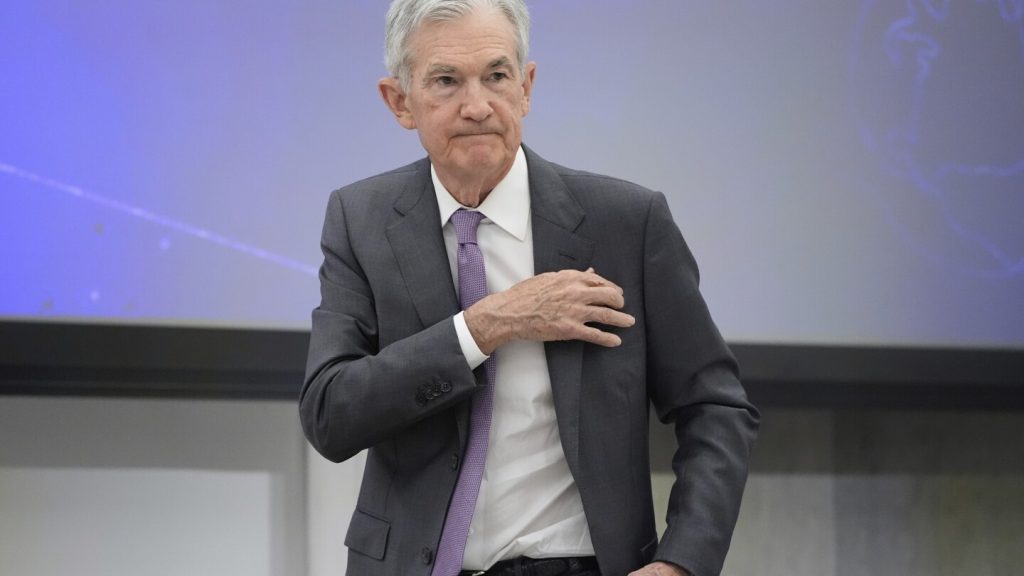WASHINGTON (AP) — The U.S. economy is mostly in good shape but that isn’t saving Federal Reserve chair Jerome Powell from a spell of angst.
As the Fed considers its next moves during a two-day meeting this week, most economic data looks solid: Inflation has been steadily fading, while the unemployment rate is still a historically low 4.2%. Yet President Donald Trump’s widespread tariffs may push inflation higher in the coming months, while also possibly slowing growth.
With the outlook uncertain, Fed policymakers are expected to keep their key interest rate unchanged on Wednesday at about 4.4%. Officials will also release a set of quarterly economic projections that are expected to show inflation will accelerate later this year, while unemployment my also tick up a bit.
The projections may also signal that the Fed will cut its key rate twice later this year, economists say.
The prospect of higher inflation would typically lead the Fed to keep rates unchanged or even raise them, while rising unemployment would usually lead the Fed to cut its key rate. With the economy potentially pulling in both directions, Powell and other Fed officials have underscored in recent remarks that they are prepared to wait for clearer signals on which way to move.
The Fed is in “an uncomfortable purgatory,” said Diane Swonk, chief economist at accounting giant KPMG. “Without the threat of tariffs, we would be seeing the Fed cut. That’s not where we’re at because of the uncertainty and the threat and the effects (of tariffs) that we don’t know yet.”
The Trump White House has sharply ramped up the pressure on Powell to reduce borrowing costs, with Trump himself calling the Fed chair a “numbskull” for not cutting and other officials, including Vice President JD Vance and Commerce Secretary Howard Lutnick, also calling for a rate reduction.
When the Fed reduces its key short-term rate, it often — though not always — leads to lower costs for consumer and business borrowing, including for mortgages, auto loans, and credit cards. Yet financial markets also influence the level of longer-term rates and can keep them elevated even if the Fed reduces the shorter-term rate it controls.
For example, if investors worry that inflation will remain elevated, they can demand higher interest rates on longer-term Treasury securities, which influence other borrowing costs.
Even though Trump has said the economy is doing well, he has also argued that a rate cut would cause the economy to take off “like a rocket.”
But Trump has also highlighted another concern: If the Fed doesn’t cut rates, the federal government will have to pay more interest on its huge budget deficits, which are projected to grow even larger under the White House’s proposed tax and budget legislation currently being considered by the Senate.
“We’re going to spend $600 billion a year, $600 billion because of one numbskull that sits here (and says), ‘I don’t see enough reason to cut the rates now,’” Trump said last week.
Pushing the Fed to cut rates simply to save the government on its interest payments typically raises alarms among economists, because it would threaten the Fed’s congressional mandate to focus on stable prices and maximum employment.
Yet the markets haven’t reacted much to Trump’s recent attacks on the Fed, now that the Supreme Court, in a ruling last month, suggested that a president doesn’t have the legal power to fire the Fed chair.
Still, with inflation remaining low, so far, despite the imposition of tariffs, the Fed may come under greater pressure in the coming months from economists and investors to cut rates. Policymakers estimate that the interest rate that would neither stimulate the economy nor slow it down — known as the “neutral rate” — is about 3%.
Meanwhile, inflation — according to the Fed’s preferred measure — is just 2.1%, almost back to the central bank’s 2% target. Such a low reading suggests the Fed’s rate should be closer to neutral, below its current level of 4.4%, because it doesn’t need a high rate to slow inflation.
“It’s a reasonable case for the Fed to grapple with,” said Jon Hilsenrath, a visiting scholar at Duke University.
Yet according to a survey Hilsenrath conducted for Duke of former Fed officials and staff, they expect the Fed to cut interest rates just once this year. “There’s a risk that inflation moves up and they don’t want to get ahead of themselves,” he said.
It’s possible that tariffs may not push up inflation as much as economists have feared. But one reason for that could be that the economy may slow, lifting unemployment and making consumers unwilling to pay higher prices, which would reduce inflation.
Economists at Goldman Sachs said in a recent research note that they expect inflation will rise to 3.6% by December, but that the increase will only be temporary.
“The main reason we are less worried is that we expect the economy to be weak this year, with … a modest rise in the unemployment rate,” Jan Hatzius, chief economist at Goldman, and his colleagues wrote.
A noticeable weakening of the economy that slows consumer spending and holds down inflation would likely lead the Fed to quickly cut rates. But they will be more comfortable doing so once they have a better sense of the full impact of tariffs.
Michael Gapen, chief U.S. economist at Morgan Stanley, said in a note Monday that the Fed “will need several months to assess the effects of policy changes, believing that ‘later and correct is better than sooner and wrong.’”

